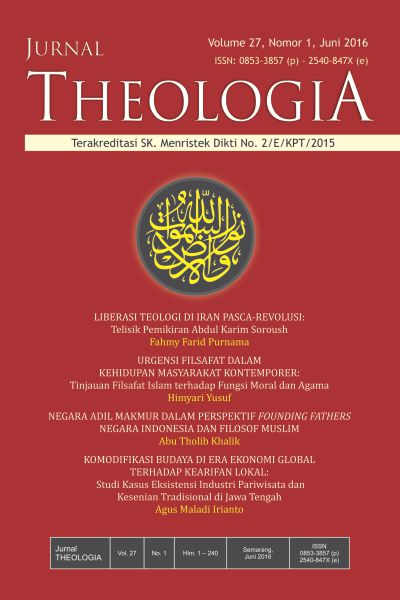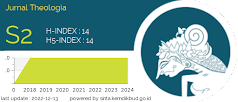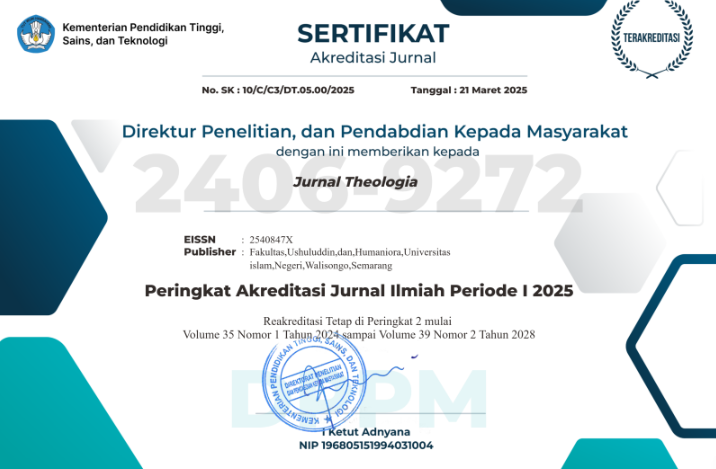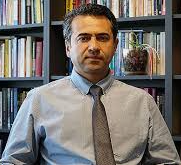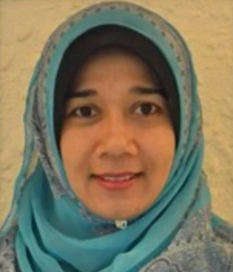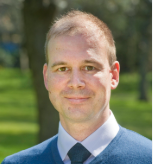LOGIKA WUJUD SADRA MERETAS NALAR RADIKALISME BERAGAMA
DOI:
https://doi.org/10.21580/teo.2016.27.1.934Keywords:
struktur logika, konsepsi wujud, Ṣadra, radikalismeAbstract
Abstract: Ṣadra was a philosopher whose thought remains unique. Its uniqueness lies in his ability to articulate the various traditions of thoughts that grew and developed rapidly in Persia, the land of his birth. The traditions were peripatetic, illuminative, gnostic, and theological tradition of Islam. It has necessitated Persia as a heterogeneous region. This heterogeneity, to some extent, can susceptibly bring conflict i.e., physical violence from hurting to even casting innocent human life. Indeed, the thought of Ṣadra was born within the era of a deep reflection process responding to the socio-cultural sphere. Also, it answered the issues that emerged at that time i.e., how the heterogeneous condition did not lead to intolerance, violence, and even acts of terror, instead created a safe, peace, and harmonious atmosphere. By his thought, Ṣadra did something very valuable to solve the problems in the country. Sadra’s thought is built up by and inherent with his basic idea, fundamental and logical structure of transcendence which are relevant to be socialized in a plural and heterogeneous society in which conflict and violence are vulnerable. Socialization of logica structure is relevant for attitudes and behaviors of people since they do not appear suddenly, yet are formed due to reason or logic or way of thinking. Thus, the study of the classical intellectual treasures potentially provides a meaningful contribution to be a basic solution for similar problems existing in nowadays.
Abstrak: Sadra adalah seorang filosof yang produk pemikirannya tergolong unik. Keunikannya terletak pada kepiawaiannya mendialogkan antar berbagai tradisi pemikiran yang tumbuh dan berkembang pesat di Persia, tanah kelahirannya. Tradisi pemikiran dimaksud adalah tradisi paripatetik, tradisi illuminatif, tradisi gnosis, dan tradisi teologi Islam. Hal ini telah meniscayakan Persia menjadi sebuah wilayah yang heterogen. Heterogenitas rentan memunculkan konflik sampai aksi kekerasan fisik yang seringkali melukai, bahkan melayangkan jiwa manusia tak berdosa. Sesungguhnya pemikiran Sadra lahir sebagai anak zaman dari sebuah proses refleksi mendalam, merespon kondisi sosial-kultural, menjawab persoalan yang berkembang saat itu: bagaimana agar sebuah kondisi yang heterogen tidak melahirkan intoleransi, kekerasan, bahkan aksi-aksi teror, tetapi justru tercipta suasana aman, damai, dan harmonis. Dari pemikiran wujudnya, Sadra melakukan sesuatu yang sangat berharga di negerinya dalam rangka memecahkan persoalan tersebut. Dalam pemikiran wujudnya ini terbangun dan inheren di dalamnya ide dasar, struktur fundamental, struktur logika transendensi yang relevan untuk disosialisasikan dalam masyarakat berbasis plural dan heterogen yang rentan konflik dan kekerasan tersebut. Sosialisasi struktur logika tersebut relevan karena sikap dan perilaku seseorang tidaklah muncul secara tiba-tiba tetapi terbentuk berkat nalar atau logika atau cara berpikir yang dimilikinya. Dari sini maka kajian terhadap khasanah intelektual masa lalu berpeluang bermakna dan bisa memberikan kontribusinya bagi dasar solusi permasalahan senada yang ada pada saat sekarang ini.Downloads
References
Acikgenc, Alparslan, Being and Existence in Ṣadra and Heidegger: A Comparative Ontology, Kuala Lumpur: ISTAC, 1993.
Fakhry, Madjid, Sejarah Filsafat Islam, terj. Mulyadhi Kartanegara, Jakarta: Pustaka Jaya, 1987.
Heriyanto, Husain, Paradigma Holistik: Dialog Filsafat, Sains, dan Kehidupan Menurut Ṣadra dan Whitehead, Bandung: Teraju, 2003.
al-Jābiri, Muḥammad ʻĀbid, Takwīn al-ʻAql al-ʻArabī, Beirut: al-Markaz al-Ṣaqafī al-ʻArabī, 1991.
al-Kadzim, Musa, “Tentang Kesatuan Wujud” dalam al-Hikmah, No. 14 Vol. VI/1995.
Kessler, Gary E. (ed.), Philosophy of Religion, California: Wadsworth, 1999.
Khudri, Dudun S., “Mulla Ṣadra, Metafisikawan Muslim Terbesar dari Safawi” dalam Republika, 6 September 2000.
Leaman, Oliver, Pengantar Filsafat Islam: Sebuah Pendekatan Tematis, terj. Musa Kadzim dan Arif Mulyadi, Bandung: Mizan, 2001.
Mahzar, Armahedi, Integralisme, Sebuah Rekonstruksi Filsafat Islam Bandung: Pustaka Salman: 2003.
Morris, James Winston, Mulla Ṣadra: Kearifan Puncak, terj. Dimitri Mahayana dan Dedi Djuniardi, Yogyakarta: Pustaka Pelajar, 2001.
Mundiri, Logika, Jakarta: Raja Grafindo Persada, 1998.
Muttahhari, Murtadha, Tema-tema Penting Filsafat Islam, terj. A. Rifai Hasan dan Yulian L., Bandung: Mizan, 1993.
Nasr, S. Hossein, Oliver Leaman (ed.), History of Islamic Philosohpy, Part I, London and New York: Routledge, 1996.
Nur, Syaifan, “Arti Penting Mulla Ṣadra dan Karakteristik Aliran Pemikirannya” dalam al-Jami'ah, No. 59/1996.
__________, “Tradisi Intelektual di Kawasan Persia: Melacak Setting Historis Pemikiran Mulla Ṣadra” dalam Esensia, Vol.3, No.1, Januari 2002.
__________, Filsafat Mulla Ṣadra: Pendiri Mazhab al-Hikmah al-Mutaaliyah, Jakarta: Teraju, 2003.
__________, Filsafat Wujud Mulla Ṣadra, Yogyakarta: Pustaka Pelajar, 2002.
Rachman, Budhy Munawar, Islam Pluralis: Wacana Kesetaraan Kaum Beriman, Jakarta: Paramadina, 2000.
Rahman, Fazlur, Filsafat Ṣadra, terj. Munir A. Muin, Bandung: Pustaka, 2000.
__________, The Philosophy of Mulla Ṣadra, Albany: State University of New York Press, 1975.
Rakhmat, Jalaluddin, “Hikmah Mutaaliyah: Madzhab Filsafat Islam Pasca Ibnu Rusydi” dalam al-Hikmah, No.10, Juli-September 1993.
Syarif, MM (ed.), History of Muslim Philosophy, Weisbaden: OttoHarrasowitz, 1963.
Yazdi, Mehdi Ha’iri, Ilmu Hudhuri: Prinsip-Prinsip Epistemologi dalam Filsafat Islam dari Suhrawardi Via Wittgenstein, terj. Ahsin Mohammad, Bandung: Mizan, 1996.

